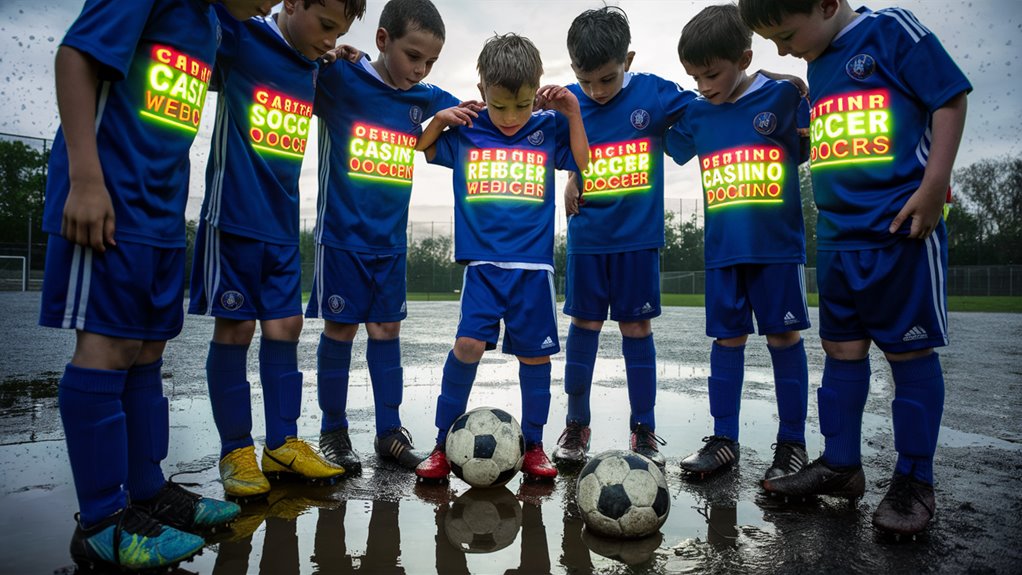어린이 스포츠 유니폼에 대한 도박 스폰서십의 세계적 문제
청소년 스포츠에 대한 도박 스폰서십의 세계적 영향
어린이 스포츠 마케팅에서의 위기 확산
도박 스폰서십은 어린이 스포츠에 빠르게 침투하고 있으며, 현재 전 세계적으로 250개 이상의 팀이 어린이 유니폼에 도박 관련 로고를 표시하고 있다. 이는 다섯 살 어린이까지 포함된 전례 없는 노출이며, 스포츠에 대한 인식과 발달에 심각한 영향을 미치고 있다.
건강 및 발달상의 위험
연구에 따르면 도박 마케팅에 일찍 노출된 경우, 문제 도박 행동을 보일 가능성이 3배 높아진다. 도박 광고에 노출된 어린 운동선수들은 불안과 우울증 비율이 높으며, 팀 내 역학도 크게 흐트러진다. 이러한 심리적 영향은 발달의 중요한 시기에 더욱 심각하게 작용한다.
롤모델 효과
도박 스폰서가 부착된 유니폼을 입은 프로 운동선수들은 어린 시청자들에게 강력한 긍정적 연상을 만든다. 이로 인해 도박 행위가 운동 문화의 일부처럼 보이게 되며, 이는 운동선수를 우상시하는 어린이들에게 특히 위험하다.
현재 규제 현황
일부 국가들은 도박 마케팅에 대한 강력한 규제를 시행하고 있지만, 전 세계적으로는 아직 분열된 대응이 이어지고 있다. 도박 기업들이 청소년 스포츠 스폰서십의 규제 허점을 악용하고 있어, 국제적 통합 기준의 필요성이 그 어느 때보다 절실하다.

보호 및 예방 조치
- 청소년 스포츠 유니폼에 도박 로고 완전 금지
- 청소년 경기 중 도박 광고에 대한 엄격한 규제
- 청소년 선수 대상 도박 위험 교육 프로그램 강화
- 일관된 보호 지침을 위한 국제 협력
이러한 조치는 스포츠 속 도박 마케팅의 영향을 차단하고 청소년 선수를 보호하는 데 필수적이다.
청소년 스폰서십의 현재 범위
도박과 청소년 스포츠 스폰서십: 커지는 우려
도박 산업의 참여 증가
도박 회사들은 청소년 스포츠에 적극적으로 스폰서십을 확대해왔으며, 유럽 청소년 축구 리그에서만 250건 이상의 스폰서 계약을 체결하였다. 도박 로고는 다섯 살 어린이의 유니폼, 스포츠 장비, 경기장 광고판 등에 광범위하게 등장하고 있다.
다종목 및 지역 확산
이 현상은 축구를 넘어 농구, 크리켓, 럭비 등 다양한 청소년 스포츠로 확대되었다. 특히 도박 기업들은 저소득 지역의 스포츠 프로그램을 전략적으로 겨냥해 막대한 재정 지원을 제공하고 있으며, 이는 자금이 부족한 단체들에게 거절하기 어려운 제안이 되고 있다. 도박 로고가 부착된 유니폼은 XXXS 사이즈까지 제작된다.
재정 규모 및 인프라 투자
지난해 도박 산업의 청소년 스포츠 투자 규모는 1억 5천만 달러에 달했다. 주요 투자 항목은 다음과 같다:
- 대회 명명권
- 브랜드가 삽입된 훈련 장비
- 청소년 개발 시설
- 아카데미 스폰서십
이로 인해 청소년 스포츠 환경 전반에 도박 이미지와 브랜딩이 깊이 통합되었고, 어린이의 운동 환경이 본질적으로 변화되었다.
조기 도박 노출의 이해
어린이 발달에 미치는 도박 노출의 영향
도박 마케팅에 대한 아동기 노출의 이해
어린 시절 도박 광고에 노출되는 것은 아이들의 도박 및 게임 활동에 대한 인식에 큰 영향을 미친다. 8세에서 16세 사이의 아동이 스포츠 유니폼 등에 도박 로고를 자주 접하면, 스포츠 내 도박을 당연하게 여기는 인식이 형성된다. 이 과정은 인지 발달과 위험 판단 능력에 문제를 일으킨다.
스포츠 마케팅과 심리적 영향
운동복에 부착된 도박 로고는 강력한 심리적 연상을 유도한다. 아이들은 자신이 존경하는 스포츠 스타들이 도박 관련 유니폼을 입은 모습을 통해 무의식적으로 도박에 긍정적 인식을 가지게 된다. 이러한 노출은 마케팅 영향에 취약한 발달 시기에 발생하여 핵심 가치 형성에 영향을 준다.
연구 기반 결과
정기적으로 도박 광고에 노출된 아동은 청소년기에 문제 도박 행동을 보일 확률이 3배 증가한다는 통계적 증거가 있다. 스포츠와 도박 홍보의 결합은 스포츠 경기와 도박 활동의 경계를 모호하게 하며, 이를 평범한 여가활동으로 오인하게 만든다.
장기적 결과
현재의 마케팅 환경은 도박 관련 피해로부터 아동을 보호하는 데 상당한 어려움을 안긴다. 스포츠 미디어와 상품을 통한 체계적인 노출은 조기 도박 인식을 확산시키며, 향후 행동 패턴에도 장기적 영향을 줄 수 있다.
건강 및 심리적 영향

청소년 스포츠에서 도박 마케팅이 미치는 건강 및 심리적 영향
청소년 선수의 정신 건강 영향
스포츠 환경에서의 도박 마케팅 노출은 어린이와 청소년의 심리에 심각한 위험을 초래한다. 이로 인해 불안, 우울증, 자존감 저하가 증가하며, 일부 어린이들은 자신의 실력이 아닌 도박 배당률을 중심으로 스포츠를 인식하게 된다.
신경 발달과 행동 변화
도박 행동의 정상화는 아동의 뇌 발달에 악영향을 미친다. 연구에 따르면, 도박 광고에 노출된 아이들은 18세까지 문제 도박 행동을 보일 가능성이 유의하게 높다. 이는 스포츠 참여에 대한 인식을 성취감과 팀워크에서 금전적 보상 중심으로 바꾸는 신경 회로의 재구성으로 이어진다.
장기 심리 효과
도박 스폰서의 광범위한 존재는 청소년에게 측정 가능한 심리적 부담을 초래한다. 도박 회사를 대표하는 유니폼과 장비를 착용해야 하는 상황은 다음과 같은 문제를 야기할 수 있다:
- 팀 내 상호작용의 붕괴
- 가치관 왜곡
- 건전하지 못한 금전 인식
- 기술 발전에 대한 집중 저하
- 스포츠 참여의 즐거움 감소
이러한 요소의 복합 작용은 정신 건강과 운동 능력 발달에 장기적인 영향을 미치며, 포괄적인 보호 전략이 요구된다.
법적 체계와 규제
청소년 스포츠에서의 도박 스폰서십 관련 법적 프레임워크
규제 현황 및 시행의 어려움
전 세계적으로 도박 스폰서십을 규제하는 법적 체계는 일관성이 부족하며, 아동 보호 측면에서 심각한 우려를 야기한다. 일부 국가는 유소년 유니폼에 도박 로고를 엄격히 금지하지만, 많은 국가는 기본적인 보호 조치조차 마련하지 않아 어린 선수를 마케팅 피해에 노출시키고 있다.
입법적 공백과 이행 문제
기존 도박 관련 법률 분석 결과, 다음과 같은 허점이 존재한다:
- 모기업과의 파트너십을 통한 우회 스폰서십
- 간접 브랜딩
- 은밀한 마케팅 전략
- 약한 집행 체계
국제 기준 제안
- 청소년 스포츠에서 도박 로고의 전면 금지
- 강력한 벌금과 집행 시스템 마련
- 규제 준수를 위한 고급 감시 체계 구축
- 스폰서 규제에 대한 명확한 지침
법제화 이행 프레임워크
- 청소년 복지 보호 우선 원칙
- 표준화된 집행 프로토콜
- 국경 간 규제 협력 체계
- 정기적 평가 시스템 구축
규제 불균형 해소를 위한 국제적 협력이 필요하며, 도박 산업의 영향력으로부터 청소년 스포츠를 보호하기 위한 포괄적 안전망 구축이 필수적이다.
글로벌 대응 및 정책 변화
스포츠 도박 스폰서 규제의 글로벌 변화와 영향
국제 정책 개혁
최근 도박 스폰서십으로부터 아동을 보호하려는 전 세계적인 노력이 규제 환경을 크게 변화시키고 있다. 이탈리아, 스페인, 호주는 청소년 스포츠 유니폼에 도박 로고를 금지하는 강력한 규제를 시행하였다. 영국은 청소년 보호 강화를 위한 정책 검토에 착수하였다.
EU의 통합 규제 접근
유럽연합은 다음을 포함한 표준화된 규제안을 통해 리더십을 보이고 있다:
- 위반 시 강력한 제재
- 도박 위험에 대한 교육 프로그램 의무화
- 국경 간 준수 기준 마련
- 청소년 보호 프로토콜 구축
풀뿌리 영향 및 산업 대응
아동 옹호 단체와 학부모 단체는 정책 변화를 주도하고 있으며, 주요 스포츠 단체는 법적 의무 이전에 자발적으로 스폰서 기준을 강화하고 있다.
글로벌 이행 일정
전 세계적으로 규제 도입이 확대되고 있으며, 향후 24~36개월 내에 전 세계적인 기준 확립이 가시화되고 있다. 일관된 도박 스폰서십 규제 프로토콜이 마련될 전망이다.
집행 및 준수
규제 준수를 위한 감시 체계가 마련되었으며, 국제 협력을 통해 모든 관할구역에서 일관된 집행이 가능하다. 주요 스포츠 기구는 도박 영향력으로부터 청소년 선수를 보호하기 위해 전담 준수 부서를 운영 중이다.
청소년 스포츠를 위한 대체 자금 조달
도박 스폰서십을 대체할 지속 가능한 자금 모델
지역 기반 자금 조달
지역 기업 파트너십 및 커뮤니티 주도형 모금은 지역 연계성을 강화하면서 안정적인 수익을 창출할 수 있다. 건강, 교육, 스포츠 제조업체 등 도박과 무관한 기업들이 긍정적 가치와 연계된 파트너십을 제공한다.
정부 및 지자체 지원
공공 자금과 보조금은 청소년 스포츠에 안정적인 재정을 제공한다. 주요 항목은 다음과 같다:
- 청소년 전용 예산 편성
- 시설 개발 자금
- 장비 및 장소 보조금
- 코치 교육 예산
기업 파트너십 기회
기술, 금융, 헬스케어 부문의 도박과 무관한 기업들은 다음과 같은 이점을 제공한다:
- 재정 안정성
- 교육 자료
- 기술 인프라
- 전문성 개발 지원
디지털 자금 조달
- 크라우드 펀딩 캠페인
- 온라인 회원 프로그램
- 기부 포털
- 투명한 재정 추적 시스템
참여 기반 수익 구조
- 계층형 회원제
- 가족 참여 패키지
- 시즌별 프로그램 이용료
- 장비 대여 프로그램
청소년 보호를 위한 향후 해결 방안
정책 개혁 및 입법 조치
- 청소년 스포츠 유니폼 및 장비에 도박 로고 전면 금지
- 막대한 벌금과 체계적 감시 프로토콜 포함한 집행 체계 구축
교육 이니셔티브 및 미디어 리터러시
학교 교육 과정에 도박 인식 교육을 포함해야 하며, 학생들이 다음을 수행할 수 있어야 한다:
- 조작적 마케팅 전략 인식
- 도박 위험 이해
- 광고 분석을 위한 비판적 사고력 함양
- 도박 메시지에 대한 저항력 형성
청소년 스포츠 단체의 책임성 강화
- 대체 자금 조달 체계 마련
- 스폰서 공개 보고 의무화
- 윤리적 스폰서 가이드라인 수립
- 정기적 준수 감사 시행
국제적 조정 및 기준 마련
- 통합 국제 기준 설정
- 성공적 개입 전략 공유
- 일관된 규제 프레임워크 도입
- 도박 산업 활동에 대한 글로벌 감시 체계 구축
- 공동 집행 메커니즘 개발
이러한 방안은 청소년을 도박 영향력으로부터 보호하고, 청소년 스포츠의 지속 가능한 발전을 위한 재정 기반을 마련하는 데 기여한다.






